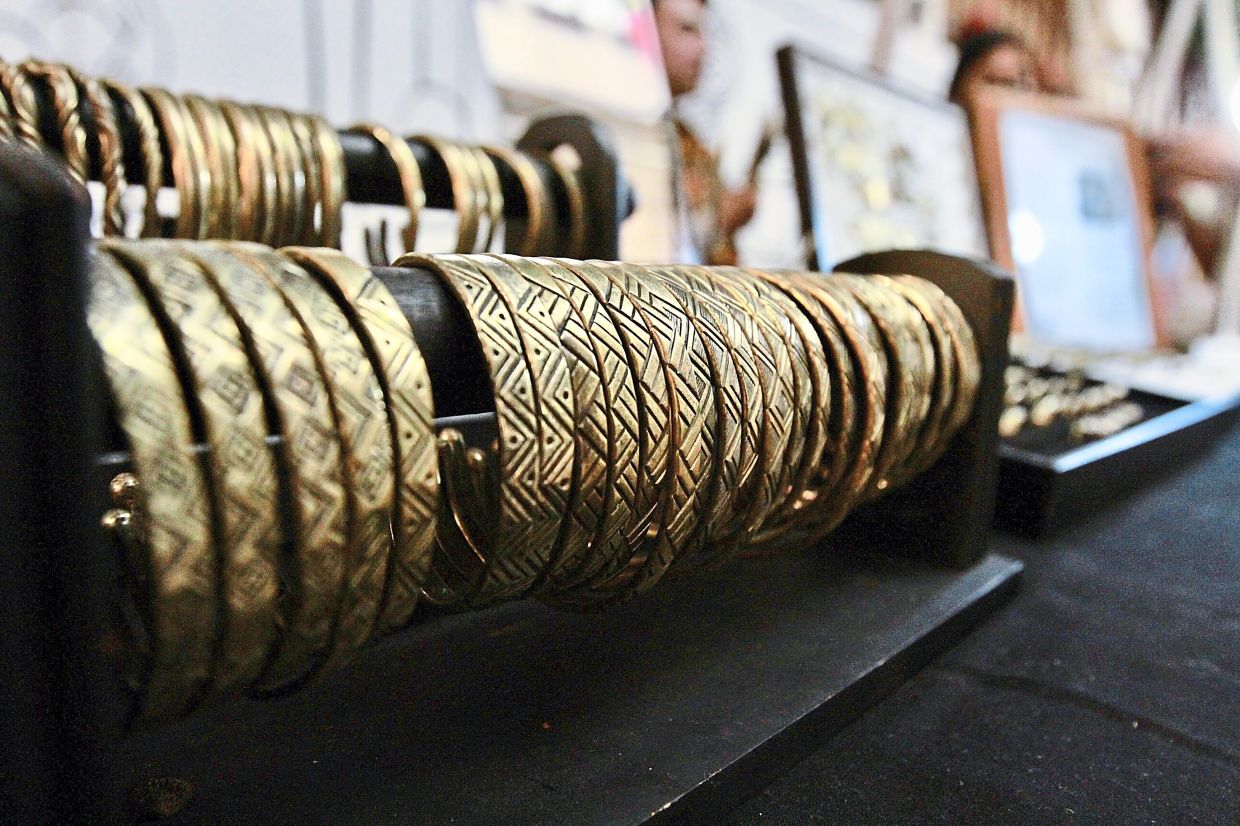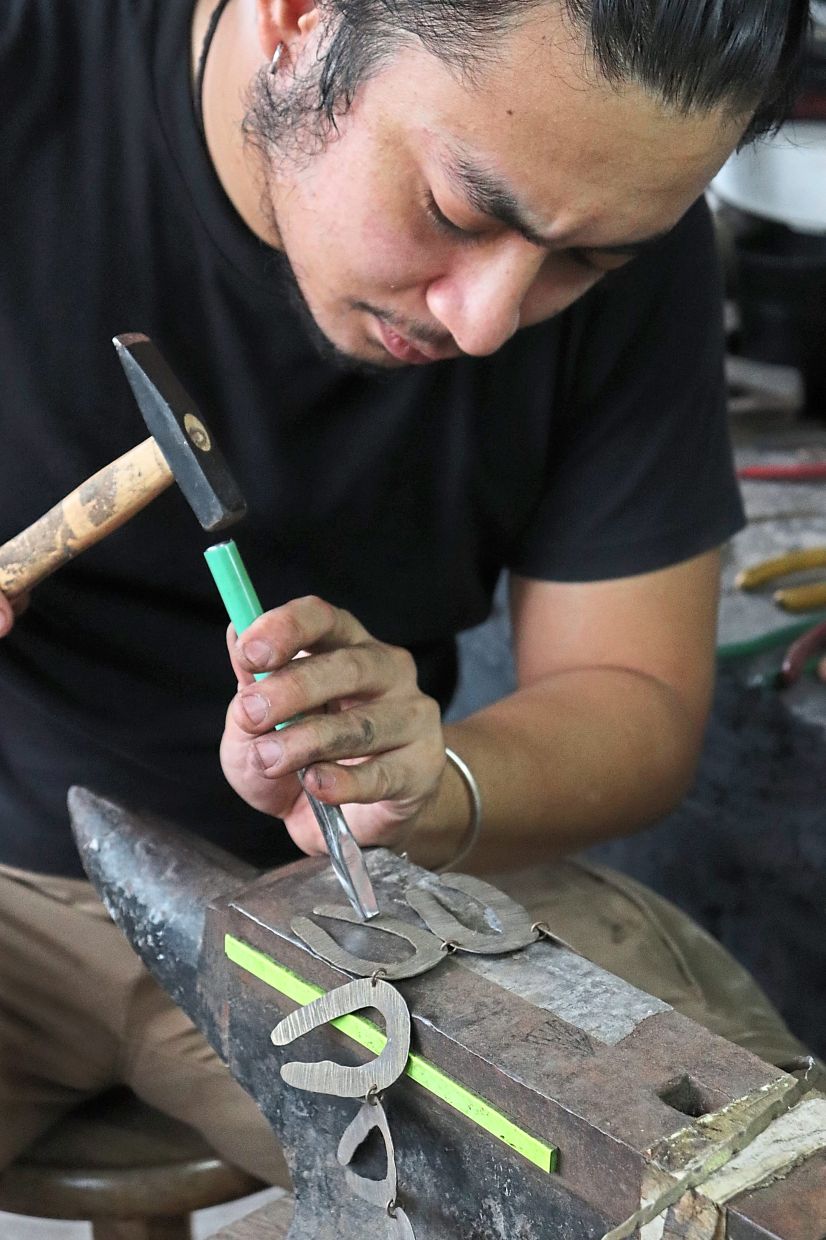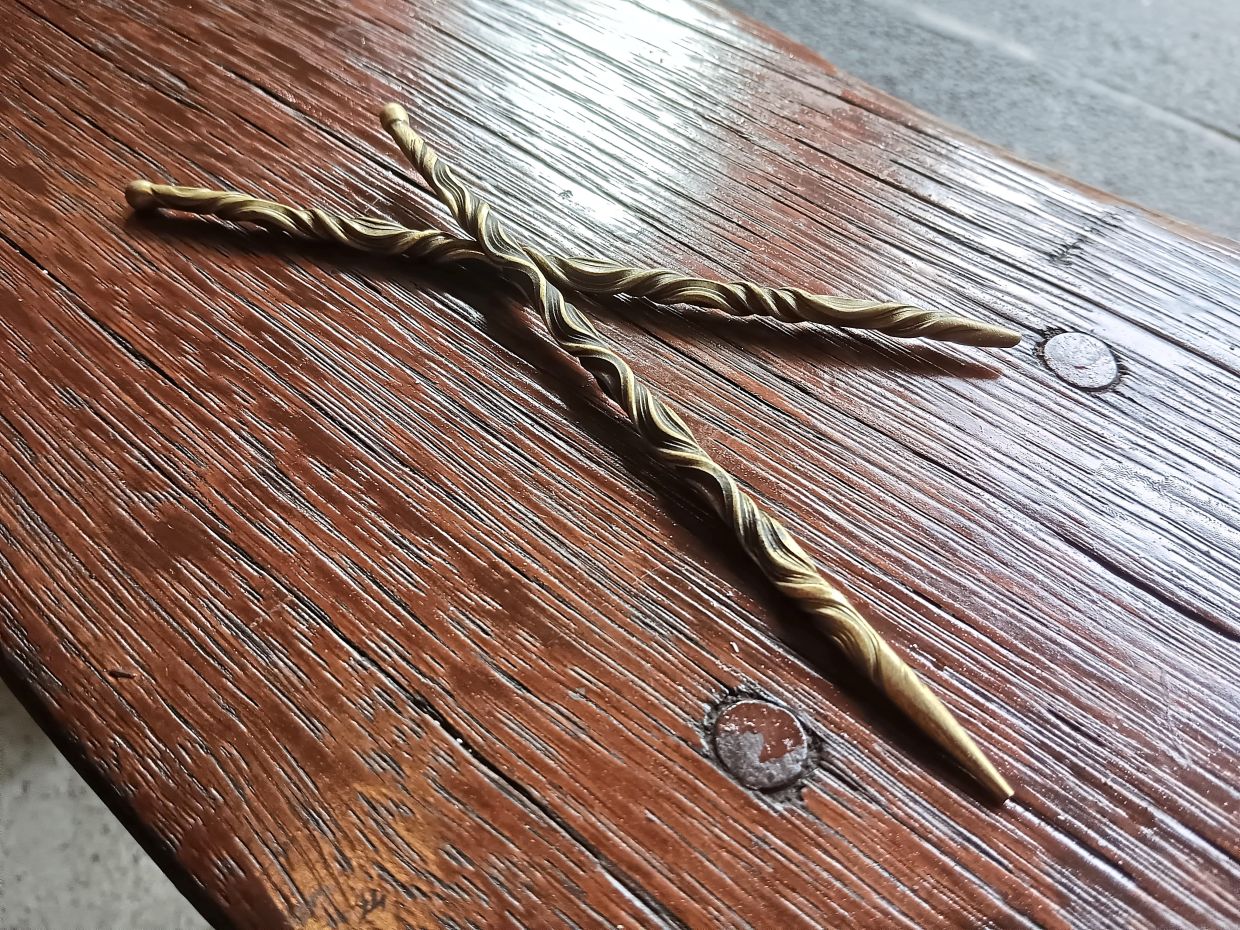Crafting intricate jewellery from brass is a time-consuming process, says Labunda. Photos: The Star/Low Lay Phon
When Jason Labunda was a young boy, he would listen with rapt attention as his grandmother told him Sabah folklore stories, such as The Dragon of Kinabalu, The Chinese Prince and the Kadazan Maiden and The Shipwrecked Prince.
He learnt about Sabah’s rich history, folklores, myths, legends that hark back centuries and his Kadazan grandmother, Bobohizan (high priestess) Tomunsi Matanul, enjoyed sharing these tales with Labunda before bedtime.
Listerning to the fascinating stories, and watching his grandmother perform traditional ceremonies, left a deep imprint on the young Labunda.
“I have a clear recollections of my grandmother performing traditional ceremonies. She would chant while shaking a brass instrument called the sindavang to the accompaniment of brass gongs,” says Labunda, 30, from Penampang, Kota Kinabalu where he lives.
All of this showed the Kadazan metalsmith the richness of his culture and heritage and he realised how important it was to keep these stories as well as his culture alive and pass it down to future generations.
And, now, he does just this with his hand-crafted brass jewellery.
“I’ve always like working with my hands to create brass tools and jewellery. Then, over the years, my interest in creating jewellery grew, so I incorporated these myths into my creations. And I chose brass because growing up in the kampung, brass tools were used in daily life and also culturally,” he says.
Labunda launched Vuhanut, a home-based jewellery line, in 2020. Working with brass and wood, he creates accessories like necklaces, rings, hairpins and cuffs – all of which tell a story, or two.
“Through the art of storytelling in my designs, I hope to contribute to preserving my indigenous culture. I enjoy working with metal. I also like the deceptive illusion of gold that brass possesses, as well how rustic it look as it ages.”
Labunda hopes that his work, as well as that of other Bornean jewellery makers, will in some way inspire youngsters to learn about their roots and culture and respect the “old ways of living in harmony with nature”.
“With globalisation, it is only natural for people to adapt to the modern world. However, that also can mean the loss of cultural knowledge, such as oral traditions, which are normally passed down from the old to young.
“This could cause the loss of indigenous knowledge and practices, even the knowledge of our local flora and fauna.
“Hopefully, my creations will inspire some who share the same interest in culture and caring for our earth. I admire indigenous communities’ way of living and how they live in harmony with nature,” he says.
An early start
It was his father, Fredoline Labunda, who first introduced him to woodworking when he was in primary school.
“My earliest memory was of my father teaching me to make a small wooden wheelbarrow for a school project. I scored high marks for the project. Later, it was purchased by one of the teachers,” says Labunda, the youngest of five siblings.
In his teen years, he became interested in jewellery crafting and, through trial and error, he would improve his craftmanship, trying techniques that he’d read about in books or watch in video tutorials.
After completing his Form Five, he came to Kuala Lumpur to pursue his studies in business management. However, he had to drop out of college as he couldn’t afford the fees.
“In 2013, I moved back to Kota Kinabalu, and the following year I started making accessories on a part-time basis, under the brand Pogunsavat (which means high land area in Kadazan) Craftwork. I also did other part-time jobs... I worked as a cleaner, waiter and gardener to support my growing, expensive, obsession with metalwork and woodwork.”
Then, at the the end of 2019, he came back to Kuala Lumpur for “the illusion of greener pastures”. However, when he started reading reports about the spread of the coronavirus, he had a niggling feeling that “something bad was coming” and made a quick decision to return home to Sabah.
“My instincts proved me right, because in March 2020, Malaysia went under lockdown. Stuck in quarantine for months at my family home and running out of movies to watch on Netflix, I eventually decided to spend time in my workshop.
“I picked up my tools and started beating away at whatever unfortunate piece of metal was within the vicinity, I felt a sudden rush of life in my heart. At that moment, I realised that this is what I want to do,” he says.
Turning to tradition
Crafting intricate jewellery is a process of many steps, and also time-consuming, Labunda says. After creating a rough sketch of the piece he has in mind, Labunda chooses the materials he wants to use, the tools and techniques he needs to employ.
He then gets to cutting the required amount of material and begins heating them in a charcoal fire pit in a process called annealing, to soften the metal enough to be worked on.
“After the metal has been softened, I proceed to beat it into shape. I throw it back into the fire every once in a while to soften the parts that have been hardened again.
“Once I have achieved the desired shapes, I test the pieces for durability, and rough out any sharp edges that would hurt the wearer before bathing the pieces in an acid wash made up of natural acids from citrus fruits,” says Labunda, who sources his material from metal suppliers and hardware shops in Kota Kinabalu.
Once the pieces are cleaned, he decorates the surface by texturing and hammering using an array of chisels, engravers, and hammers. After stamping the piece with his brand logo, he does the finishing of the piece and gives it a polish.
Once ready, he posts photos of his creations on his Instagram.
His main tools comprise a variety of hammers, chisels, pliers, and an anvil.
“I still work mainly with manual tools as electricity supply still gets cut off frequent in my kampung,” he shares.
It takes anywhere between four hours to a week to create his pieces. For example, a hairpin would typically take up to four hours to make while a bigger piece, like an indigenous deity-themed neckpiece, can take up to a week. The starting price of his handcrafted items is RM30. On average, he makes about RM2,000 a month.
Most of the inspiration for his work comes from nature and his heritage, he says. One of his oft-repeated designs is of spiralling ferns.
“Nature is definitely an inspiration. The textures, patterns, and smell of nature... I love it all. I also admire the simplicity, yet elegant, patterns of traditional native art and how they were once a written record of historical events, tales, and mythologies. I channel inspiration from all this into my work, and use my art pieces as another medium for storytelling,” he says.
He also draws inspiration from other cultures like the that of the Mayan Aztec, Polynesian and Celtic communities.
“What I enjoy most from learning about all these cultures is finding out about the histories of these people – where they came from, and how they viewed their world during their time.
“Although different indigenous cultures are separated geographically, I have found that there are many similarities in the motifs of their artwork.”
Labunda loves what he does but admits that earning a living as a metalsmith can be challenging.
“With the current economic situation... inflation has proven to be a challenge. Like many Malaysians, I too find it difficult to earn a living sometimes. Fatigue is also another challenge as the work is labour intensive. Like an ageing clock, I can hear the clicks and clacks in my movements now,” he says.
His parents are concerned about his livelihood too and worry if he can sustain a living with this career in craft.
“They would still rather I become a doctor, lawyer, engineer or priest. Asian parents bah.”
Still, Labunda isn’t swayed.
“I would also love to be under air conditioning and not have flying sparks spitting at me. But I can never shake off the itch to get my hands dirty or to beat hot metal. I may be sacrificing comfort, but the feeling of being alive is plenty enough motivation for me to pursue my dream of becoming an established metalsmith,” he concludes.












